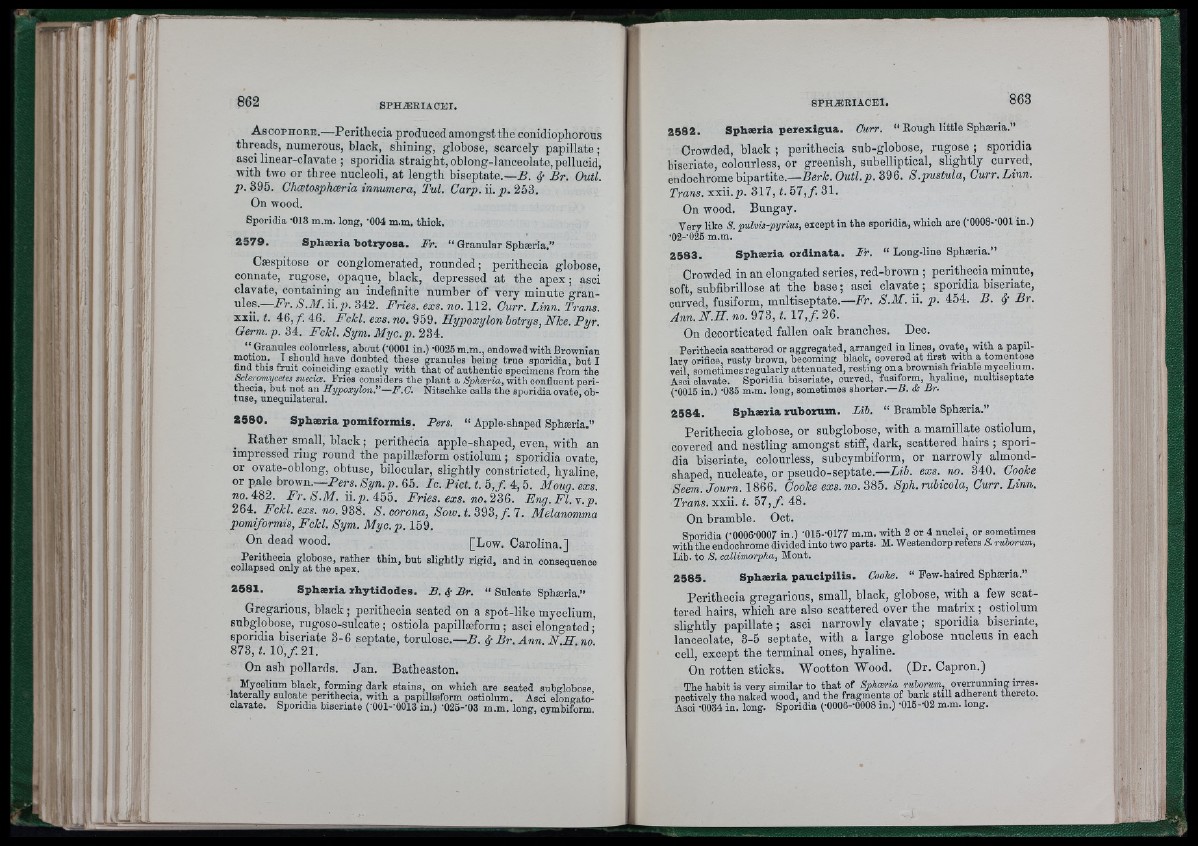
A s c o p h o r e .— Perithecia produced amongst the conidiophorous
threads, numerous, black, shining, globose, scarcely papillate ;
asci linear-clavate ; sporidia straight, oblong-lanceolate, pellucid,
with two or three nucleoli, at length biseptate.—B. & Br. Outl.
p. 395. Chætosphæria innumera, Tul. Carp.ii.p. 253.
On wood.
Sporidia '013 m.m. long, '004 m.m. thick.
2 5 7 9 . Sphæ ria botzyosa. Fr. “ Granular Sphæria.”
Cæspitose or conglomerated, rounded; perithecia globose,
connate, rugose, opaque, black, depressed at the apex ; asci
clavate, containing an indefinite number of very minute gran-
ules.—Ur. S.M. ii.p. 342. Fries, exs. no. 112. Curr. Linn. Trans.
xxii. t. 46, f. 46. FcU. exs. no. 959. Hypoxylon hotrys, Nhe. Pyr.
Oerm. p. 34. FcU. Sym. Myc.p. 234.
“ Granules colourless, about ('OOOl in.) '0025 m.m., endowed witb Brownian
morion. I should have doubted these granules being true sporidia, but I
bud this fruit coinciding exactly with th at of authentic specimens from the
&leromycetes mence. Fries considers tbe plant a Sphæria, with confluent perithecia,
but not an Hypoxylon?’—F.C. Nitsobke calls the sporidia ovate, obtuse,
uneqmlateral.
2 5 8 0 . Sphæzia p omifozmis. Pers. “ Apple-shaped Sphæria.”
Rather small, black ; perithecia apple-shaped, even, with an
impressed ring round the papillæform ostiolum ; sporidia ovate,
or ovate-ohlong, obtuse, hilocular, slightly constricted, hyaline,
or pale brown.—Ugrs. Syn.p. 65. Ic. Piet. t. 5 ,f. 4 ,5. Moug. exs.
«0.482. Ur. N.Af. ii. 73. 455. Fries, exs. no.í¿36. Eng. F I .y.p.
264. FcU. exs. «0.938. S. corona, Sow.t.393, f . l . Melanomma
pomiformis, Fckl. Sym. Myc.p. 159.
On dead wood. [Low. Carolina.]
Peritbeeia globose, rather thin, but slightly rigid, and in consequence
collapsed only at the apex.
2 5 8 1 . Sphæzia zhytidodes. B. ^ Br. “ Sulcate Sphæria.”
Gregarious, black ; perithecia seated on a spot-like mycelium,
subglobose, rugoso-sulcate ; ostiola papillæform; asci elongated ;
sporidia biseriate 3-6 septate, torulose.—B. & Br.Ann. N H no
873, 10,/. 21. ■ ■ ■
On ash pollards. Jan. Batheaston.
MyceHum black, forming dark stains, on which are seated subglobose,
laterally sulcate perithecia, witb a papillæform ostiolum. Asci elongato-
clavate. Sporidia biseriate ('OOl-'OOlS in.) -025--03 m.m. long, cymbiform.
2 5 8 2 . Sphæzia p e z e x ig u a . Curr. " Rough little Sphæria.”
Crowded, black ; perithecia sub-globose, rugose ; sporidia
biseriate, colourless, or greenish, subelliptical, slightly curved,
endochrome bipartite.—®«r¿.OMíL75. 396. S.pustula, Gurr. Linn.
Trans, xxii. p. 317, t. 51, f . 31.
On wood. Bungay.
Very like S. pulvis-pyrius, except in tbe sporidia, wbiob are ('OOOS-'OOl in.)
•02-'026 m.m,
2 5 8 3 . Sphaeiiit oxd inata. J r . “ Long-line Sphaeria.”
Crowded in an elongated series, red-brown ; perithecia minute,
soft, subfibrillose at the base ; asci clavate ; sporidia biseriate,
curved, fusiform, multiseptate.—Fr. S.M. ii. p. 454. B. & Br.
Ann. N .H. no. 973, t. 17,/. 26.
On decorticated fallen oak branches. Dec.
Peritbecia scattered or aggregated, arranged in lines, ovate, with a papillary
orifice, rusty brown, becoming black, covered at first with a tomentose
veil, sometimes regularly attenuated, resting on a brownish friable myoelmm.
Asci clavate. Sporidia biseriate, curved, fusiform, hyalme, multiseptate
(•0015 in.) ’035 m.m. long, sometimes shorter.—B. & Br.
2 5 8 4 . Sphæzia zubozum. Lih. » Bramble Sphæria.”
Perithecia globose, or subglobose, with a mamillate ostiolum,
covered and nestling amongst stiff, dark, scattered hairs ; sporidia
biseriate, colourless, suhcymbiform, or narrowly almond-
shaped, nucleate, or pseudo-septate.—Lib. exs. no. 340. Cooke
Seem. Journ. 1866. Cooke exs. no. 385. Sph. rubicela, Curr. Linn.
Trans, xxii. t. 57, f . 48.
On bramble. Oct.
Sporidia C0006-0007 in.) ■015--0177 m.m. with 2 or 4 nuclei, or sometimes
witb the endochrome divided into two parts. M. Westendorp refers S. ruborum,
Lib. to S. callimorpha, Mont.
2 5 8 5 . Sphæzia p a u c ip ilis . Coohe. “ Few-baired Sphæria.”
Perithecia gregarious, small, black, globose, with a few scattered
hairs, which are also scattered over the matrix ; ostiolum
slightly papillate; asci narrowly clavate; sporidia biseriate,
lanceolate, 3-5 septate, with a large globose nucleus in each
cell, except the terminal ones, hyaline.
On rotten sticks. Wootton Wood. (Dr. Capron.)
The babit is very similar to th at of Sphæria ruborum, overrunning irrespectively
tbe naked wood, and the fragments of bark still adherent thereto.
Asoi -0034 in. long. Sporidia C0006--0008 in.) •015--02 m.m. long.